RENAULT SCENIC 2009 J84 / 2.G Engine And Peripherals EDC16 Workshop Manual
Manufacturer: RENAULT, Model Year: 2009, Model line: SCENIC, Model: RENAULT SCENIC 2009 J84 / 2.GPages: 273
Page 1 of 273
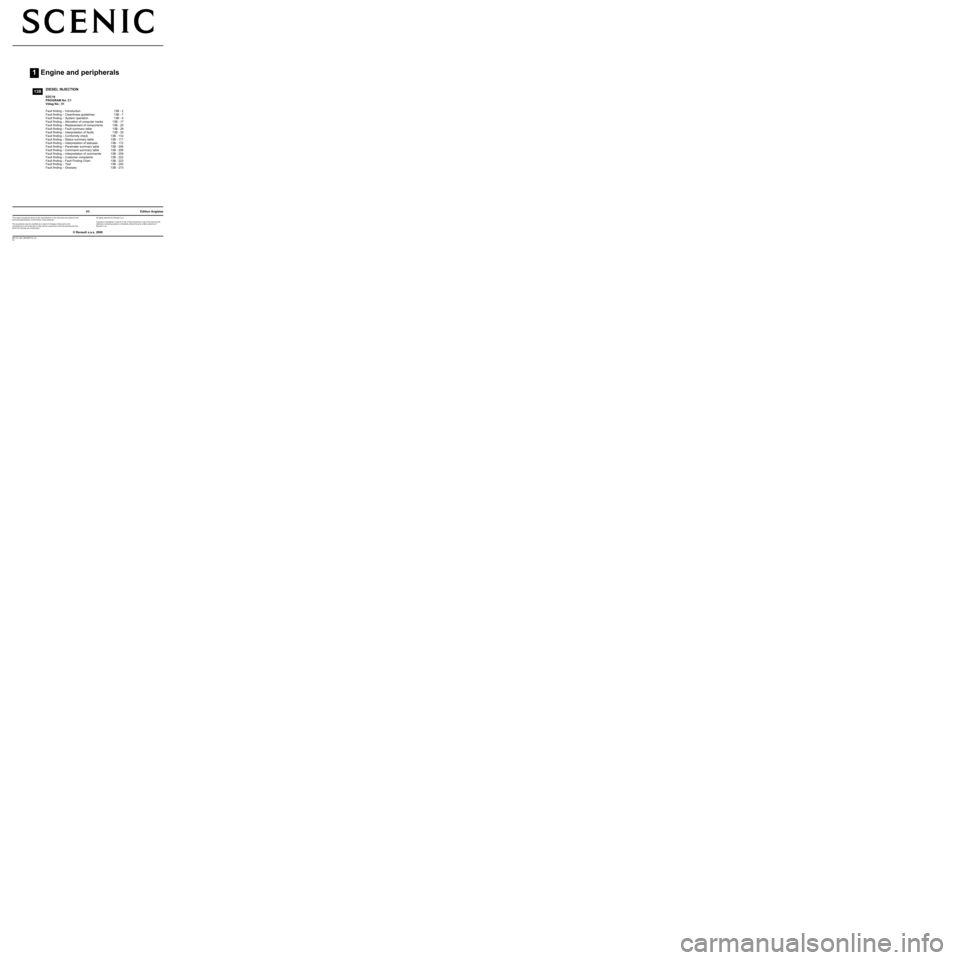
1Engine and peripherals
V3 MR-372-J84-13B250$TOC.mif
V3
13B
"The repair procedures given by the manufacturer in this document are based on the
technical specifications current when it was prepared.
The procedures may be modified as a result of changes introduced by the
manufacturer in the production of the various component units and accessories from
which his vehicles are constructed."
V3
All rights reserved by Renault s.a.s.
Edition Anglaise
Copying or translating, in part or in full, of this document or use of the service part
reference numbering system is forbidden without the prior written authority of
Renault s.a.s.
© Renault s.a.s. 2009
DIESEL INJECTION
EDC16
PROGRAM No: C1
Vdiag No.: 51
Fault finding – Introduction 13B - 2
Fault finding – Cleanliness guidelines 13B - 7
Fault finding – System operation 13B - 9
Fault finding – Allocation of computer tracks 13B - 17
Fault finding – Replacement of components 13B - 20
Fault finding – Fault summary table 13B - 26
Fault finding – Interpretation of faults 13B - 30
Fault finding – Conformity check 13B - 133
Fault finding – Status summary table 13B - 171
Fault finding – Interpretation of statuses 13B - 172
Fault finding – Parameter summary table 13B - 206
Fault finding – Command summary table 13B - 208
Fault finding – Interpretation of commands 13B - 209
Fault finding – Customer complaints 13B - 222
Fault finding – Fault Finding Chart 13B - 223
Fault finding – Test 13B - 240
Fault finding – Glossary 13B - 273
Page 2 of 273
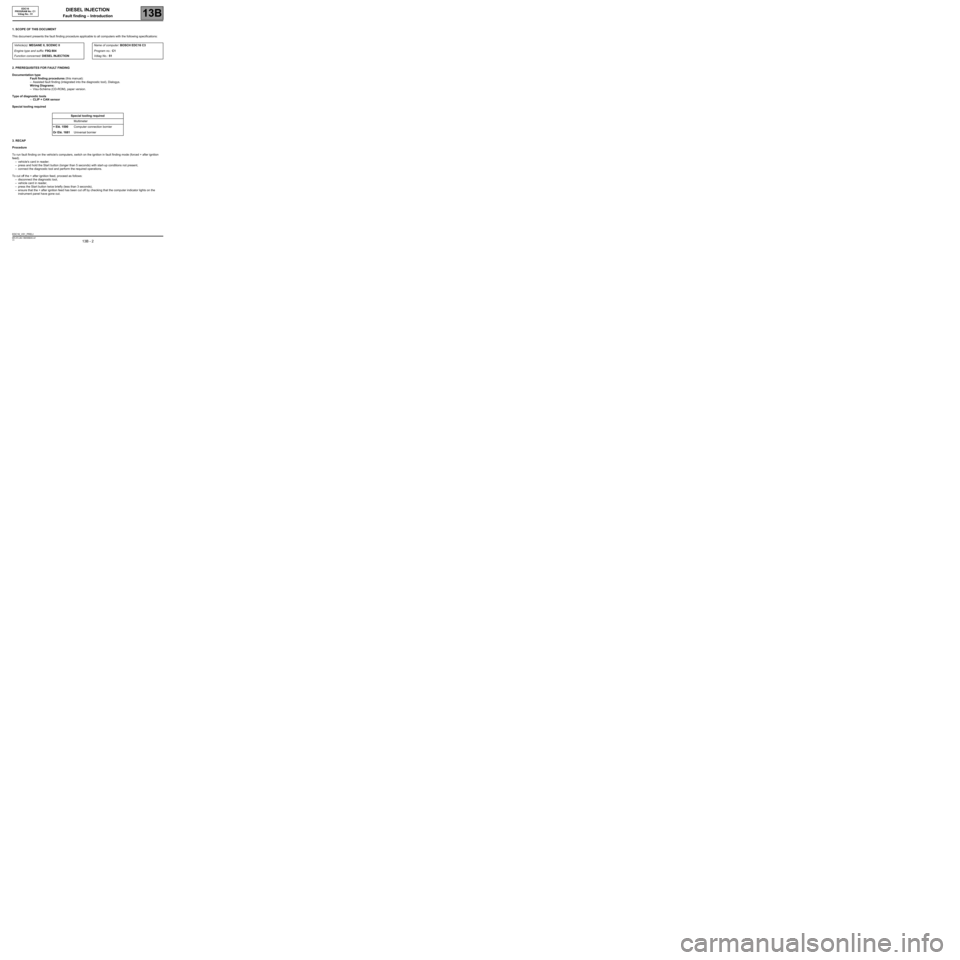
DIESEL INJECTION
Fault finding – Introduction13B
13B - 2V3 MR-372-J84-13B250$045.mif
113B
EDC16
PROGRAM No: C1
Vdiag No.: 51DIESEL INJECTION
Fault finding – Introduction
1. SCOPE OF THIS DOCUMENT
This document presents the fault finding procedure applicable to all computers with the following specifications:
2. PREREQUISITES FOR FAULT FINDING
Documentation type
Fault finding procedures (this manual):
–Assisted fault finding (integrated into the diagnostic tool), Dialogys.
Wiring Diagrams:
–Visu-Schéma (CD-ROM), paper version.
Type of diagnostic tools
–CLIP + CAN sensor
Special tooling required
3. RECAP
Procedure
To run fault finding on the vehicle's computers, switch on the ignition in fault finding mode (forced + after ignition
feed).
–vehicle's card in reader;
–press and hold the Start button (longer than 5 seconds) with start-up conditions not present,
–connect the diagnostic tool and perform the required operations.
To cut off the + after ignition feed, proceed as follows:
–disconnect the diagnostic tool,
–vehicle card in reader,
–press the Start button twice briefly (less than 3 seconds),
–ensure that the + after ignition feed has been cut off by checking that the computer indicator lights on the
instrument panel have gone out. Vehicle(s): MEGANE II, SCENIC II
Engine type and suffix: F9Q 804
Function concerned: DIESEL INJECTIONName of computer: BOSCH EDC16 C3
Program no.: C1
Vdiag No.: 51
Special tooling required
Multimeter
+ Elé. 1590Computer connection bornier
Or Elé. 1681Universal bornier
EDC16_V51_PRELI
MR-372-J84-13B250$045.mif
Page 3 of 273

DIESEL INJECTION
Fault finding – Introduction13B
13B - 3V3 MR-372-J84-13B250$045.mif
EDC16
PROGRAM No: C1
Vdiag No.: 51
Faults
Faults are declared as either present or stored (depending on whether they appeared in a certain context and have
disappeared since, or whether they remain present but have not been diagnosed within the current context).
The present or stored status of faults should be taken into consideration when the diagnostic tool is switched on
after the + after ignition feed (without any system components being active).
For a present fault, apply the procedure described in the Interpretation of faults section.
For a stored fault, note the faults displayed and apply the instructions in the Notes section.
If the fault is confirmed when the instructions in the Notes section are applied, the fault is present. Deal with the fault
If the fault is not confirmed, check:
–the electrical lines which correspond to the fault,
–the connectors for these lines (for oxidation, bent pins, etc.),
–the resistance of the component detected as faulty,
–the condition of the wires (melted or split insulation, wear).
Conformity check
The aim of the conformity check is to check data that does not produce a fault on the diagnostic tool because the
data is inconsistent. Therefore, this stage is used to:
–carry out fault finding on faults that do not have a fault display, and which may correspond to a customer
complaint.
–check that the system is operating correctly and that there is no risk of a fault recurring after repairs.
This section gives the fault finding procedures for statuses and parameters and the conditions for checking them.
If a status is not behaving normally or a parameter is outside the permitted tolerance values, consult the
corresponding fault finding page.
Customer complaints - Fault finding chart
If the test with the diagnostic tool is OK but the customer complaint is still present, the fault should be processed by
customer complaints.
A synopsis of the general procedure to follow is provided on the following page in
the form of a flow chart
Page 4 of 273
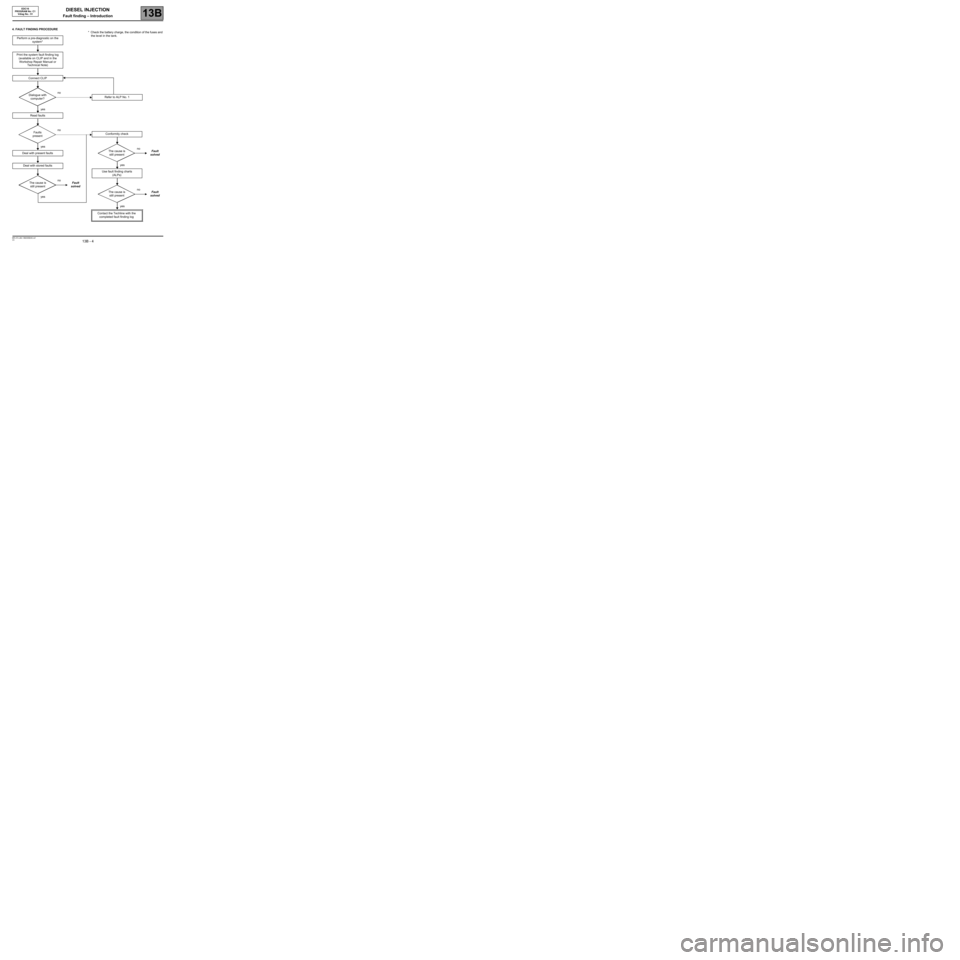
DIESEL INJECTION
Fault finding – Introduction13B
13B - 4V3 MR-372-J84-13B250$045.mif
EDC16
PROGRAM No: C1
Vdiag No.: 51
4. FAULT FINDING PROCEDURE
Perform a pre-diagnostic on the
system*
Print the system fault finding log
(available on CLIP and in the
Workshop Repair Manual or
Technical Note)
Connect CLIP
no
Dialogue with
computer?
yes
Read faults
no
Faults
present
yes
Deal with present faults
Deal with stored faults
no
The cause is
still presentFault
solved
yes
Refer to ALP No. 1
Conformity check
no
The cause is
still presentFault
solved
yes
Use fault finding charts
(ALPs)
no
The cause is
still presentFault
solved
yes
Contact the Techline with the
completed fault finding log
* Check the battery charge, the condition of the fuses and
the level in the tank.
Page 5 of 273

DIESEL INJECTION
Fault finding – Introduction13B
13B - 5V3 MR-372-J84-13B250$045.mif
EDC16
PROGRAM No: C1
Vdiag No.: 51
FAULT FINDING PROCEDURE (continued)
Wiring check
Fault finding problems
Disconnecting the connectors and/or manipulating the wiring harness may temporarily remove the cause of a fault.
Electrical measurements of voltage, resistance and insulation are generally correct, especially if the fault is not
present when the analysis is made (stored fault).
Visual inspection
Look for damage under the bonnet and in the passenger compartment.
Carefully check the fuses, insulators and wiring harness routing.
Look for signs of oxidation.
Tactile inspection
While manipulating the wiring harness, use the diagnostic tool to note any change in fault status from stored to
present.
Make sure that the connectors are properly locked.
Apply light pressure to the connectors.
Twist the wiring harness.
If there is a change in status, try to locate the source of the fault.
Inspection of each component
Disconnect the connectors and check the appearance of the clips and tabs, as well as the crimping (no crimping on
the insulating section).
Make sure that the clips and tabs are properly locked in the sockets.
Check that no clips or tabs have been dislodged during connection.
Check the clip contact pressure using an appropriate model of tab.
Resistance check
Check the continuity of entire lines, then section by section.
Look for a short circuit to earth, to + 12 V or to another wire.
If a fault is detected, repair or replace the wiring harness.
Page 6 of 273
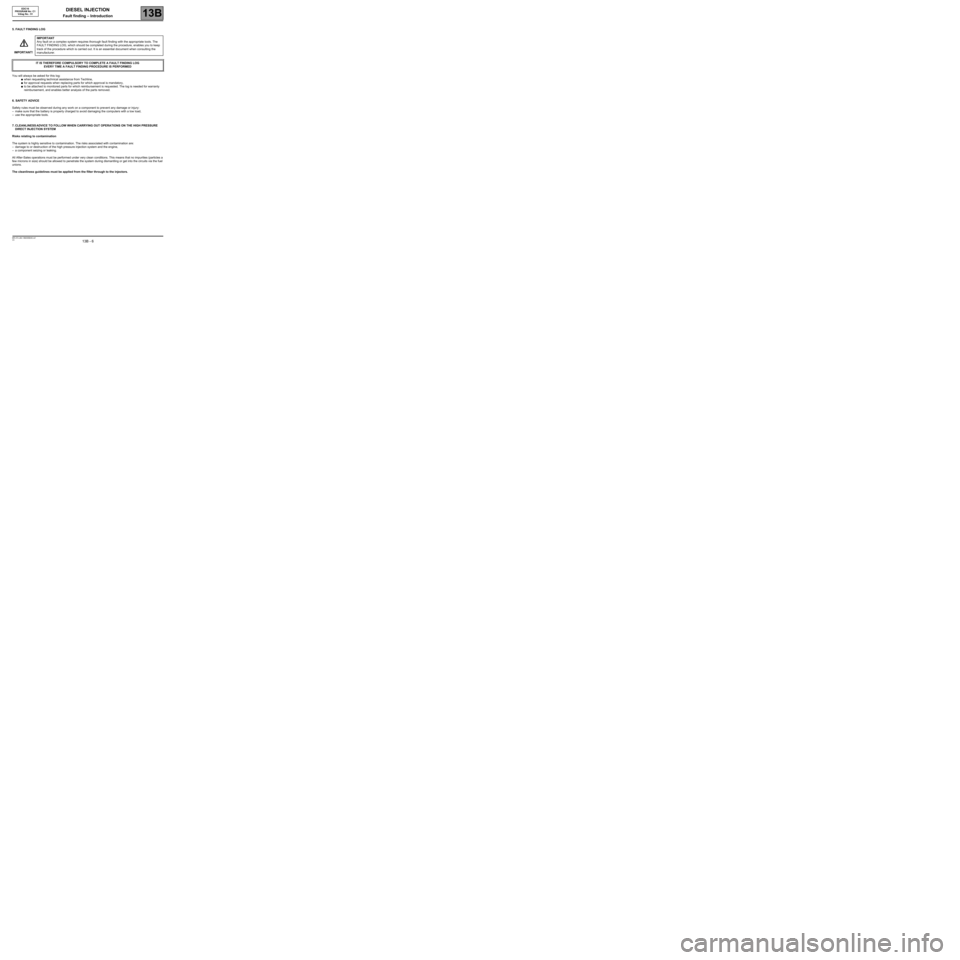
DIESEL INJECTION
Fault finding – Introduction13B
13B - 6V3 MR-372-J84-13B250$045.mif
EDC16
PROGRAM No: C1
Vdiag No.: 51
5. FAULT FINDING LOG
You will always be asked for this log:
●when requesting technical assistance from Techline,
●for approval requests when replacing parts for which approval is mandatory,
●to be attached to monitored parts for which reimbursement is requested. The log is needed for warranty
reimbursement, and enables better analysis of the parts removed.
6. SAFETY ADVICE
Safety rules must be observed during any work on a component to prevent any damage or injury:
–make sure that the battery is properly charged to avoid damaging the computers with a low load,
–use the appropriate tools.
7. CLEANLINESS ADVICE TO FOLLOW WHEN CARRYING OUT OPERATIONS ON THE HIGH PRESSURE
DIRECT INJECTION SYSTEM
Risks relating to contamination
The system is highly sensitive to contamination. The risks associated with contamination are:
–damage to or destruction of the high pressure injection system and the engine,
–a component seizing or leaking.
All After-Sales operations must be performed under very clean conditions. This means that no impurities (particles a
few microns in size) should be allowed to penetrate the system during dismantling or get into the circuits via the fuel
unions.
The cleanliness guidelines must be applied from the filter through to the injectors.IMPORTANT!IMPORTANT
Any fault on a complex system requires thorough fault finding with the appropriate tools. The
FAULT FINDING LOG, which should be completed during the procedure, enables you to keep
track of the procedure which is carried out. It is an essential document when consulting the
manufacturer.
IT IS THEREFORE COMPULSORY TO COMPLETE A FAULT FINDING LOG
EVERY TIME A FAULT FINDING PROCEDURE IS PERFORMED
Page 7 of 273
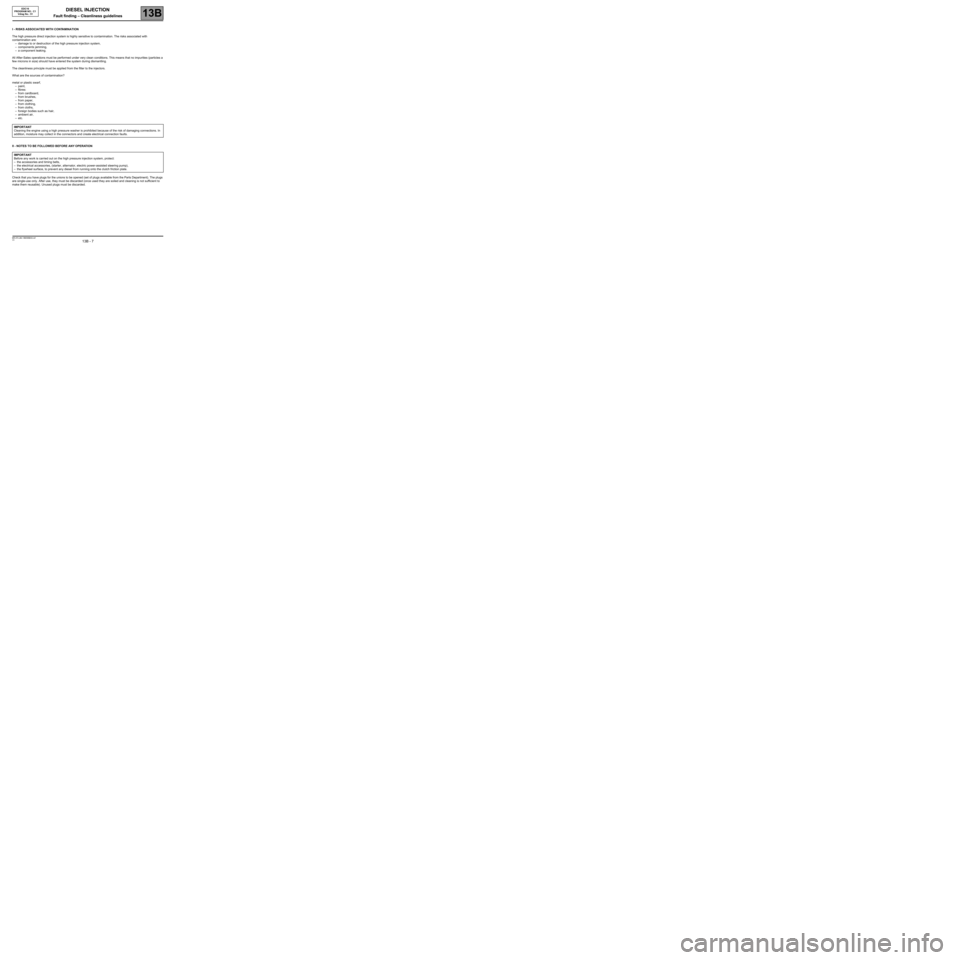
DIESEL INJECTION
Fault finding – Cleanliness guidelines13B
13B - 7V3 MR-372-J84-13B250$033.mif
EDC16
PROGRAM NO.: C1
Vdiag No.: 51DIESEL INJECTION
Fault finding – Cleanliness guidelines
I - RISKS ASSOCIATED WITH CONTAMINATION
The high pressure direct injection system is highly sensitive to contamination. The risks associated with
contamination are:
–damage to or destruction of the high pressure injection system,
–components jamming,
–a component leaking.
All After-Sales operations must be performed under very clean conditions. This means that no impurities (particles a
few microns in size) should have entered the system during dismantling.
The cleanliness principle must be applied from the filter to the injectors.
What are the sources of contamination?
metal or plastic swarf,
–paint,
–fibres:
–from cardboard,
–from brushes,
–from paper,
–from clothing,
–from cloths,
–foreign bodies such as hair,
–ambient air,
–etc.
II - NOTES TO BE FOLLOWED BEFORE ANY OPERATION
Check that you have plugs for the unions to be opened (set of plugs available from the Parts Department). The plugs
are single-use only. After use, they must be discarded (once used they are soiled and cleaning is not sufficient to
make them reusable). Unused plugs must be discarded.IMPORTANT
Cleaning the engine using a high pressure washer is prohibited because of the risk of damaging connections. In
addition, moisture may collect in the connectors and create electrical connection faults.
IMPORTANT
Before any work is carried out on the high pressure injection system, protect:
–the accessories and timing belts,
–the electrical accessories, (starter, alternator, electric power-assisted steering pump),
–the flywheel surface, to prevent any diesel from running onto the clutch friction plate.
MR-372-J84-13B250$033.mif
Page 8 of 273

DIESEL INJECTION
Fault finding – Cleanliness guidelines13B
13B - 8V3 MR-372-J84-13B250$033.mif
EDC16
PROGRAM NO.: C1
Vdiag No.: 51
Check that you have hermetically resealable plastic bags for storing removed parts. Parts stored in this way will be
less susceptible to the risk of contamination. The bags are to be used once only, and discarded after use.
Use lint-free cleaning cloths (cloth part number 77 11 211 707). Using normal cloth or paper is prohibited. They are
not lint-free and could contaminate the fuel circuit. Each cloth should only be used once.
Use fresh cleaning agent for each operation (used cleaning agent is contaminated). Pour it into an uncontaminated
container.
For each operation, use a clean brush in good condition (the brush must not shed its bristles).
Use a brush and cleaning agent to clean the unions to be opened.
Blast compressed air over the cleaned parts (tools, workbench, the parts, unions and injection system zones). Check
that no bristles remain.
Wash your hands before and during the operation if necessary.
When wearing leather protective gloves cover them with latex gloves to prevent contamination.
III - INSTRUCTIONS TO BE FOLLOWED DURING THE OPERATION
As soon as the circuit is open, all openings must be plugged to prevent impurities from entering the system. The
plugs to be used are available from the Parts Department. The plugs must not be reused under any circumstances.
Seal the pouch shut, even if it has to be opened shortly afterwards. Ambient air carries contamination.
All components removed from the injection system must be stored in a hermetically sealed plastic bag once they
have been plugged.
Using a brush, cleaning agent, air gun, sponge or normal cloth is strictly prohibited once the circuit has been opened.
These items could allow contamination to enter the system.
A new component replacing an old one must not be removed from its packaging until it is to be fitted to the vehicle.
Page 9 of 273
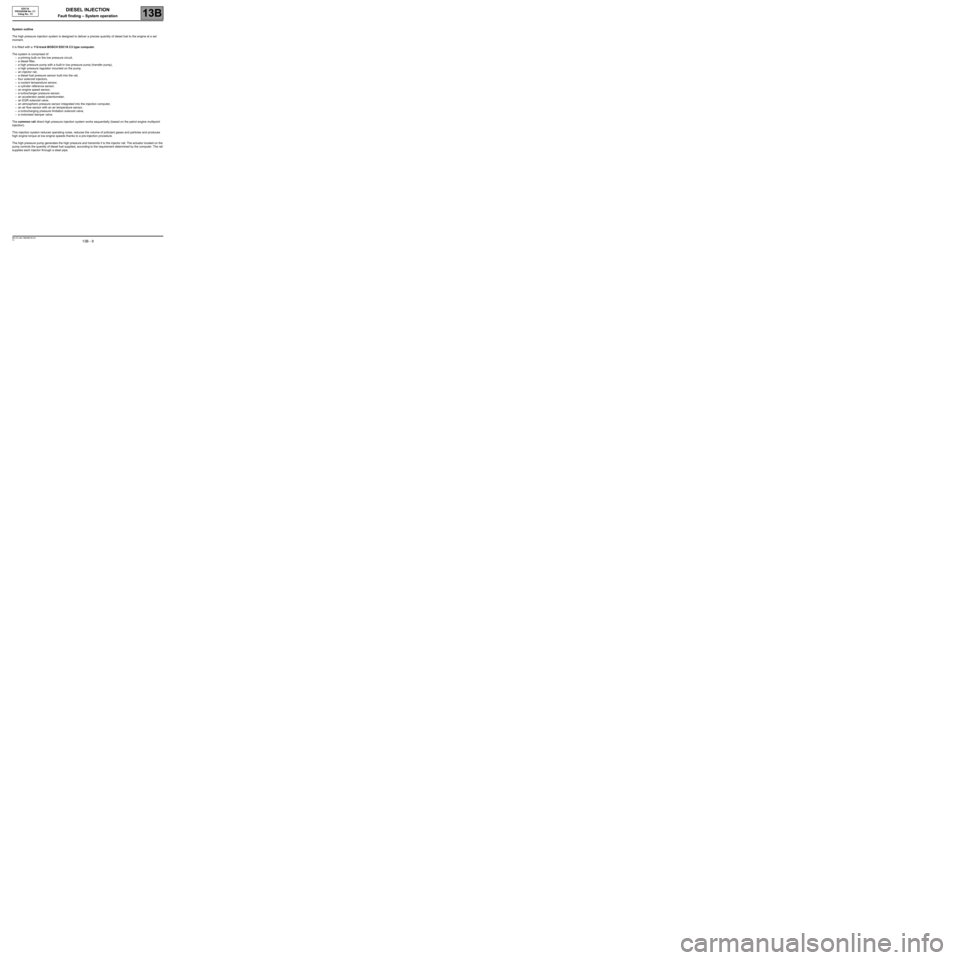
DIESEL INJECTION
Fault finding – System operation13B
13B - 9V3 MR-372-J84-13B250$135.mif
EDC16
PROGRAM No: C1
Vdiag No.: 51DIESEL INJECTION
Fault finding – System operation
System outline
The high pressure injection system is designed to deliver a precise quantity of diesel fuel to the engine at a set
moment.
It is fitted with a 112-track BOSCH EDC16 C3 type computer.
The system is comprised of:
–a priming bulb on the low pressure circuit,
–a diesel filter,
–a high pressure pump with a built-in low pressure pump (transfer pump),
–a high pressure regulator mounted on the pump,
–an injector rail,
–a diesel fuel pressure sensor built into the rail,
–four solenoid injectors,
–a coolant temperature sensor,
–a cylinder reference sensor,
–an engine speed sensor,
–a turbocharger pressure sensor,
–an accelerator pedal potentiometer,
–an EGR solenoid valve,
–an atmospheric pressure sensor integrated into the injection computer,
–an air flow sensor with an air temperature sensor,
–a turbocharging pressure limitation solenoid valve,
–a motorised damper valve.
The common rail direct high pressure injection system works sequentially (based on the petrol engine multipoint
injection).
This injection system reduces operating noise, reduces the volume of pollutant gases and particles and produces
high engine torque at low engine speeds thanks to a pre-injection procedure.
The high pressure pump generates the high pressure and transmits it to the injector rail. The actuator located on the
pump controls the quantity of diesel fuel supplied, according to the requirement determined by the computer. The rail
supplies each injector through a steel pipe.
MR-372-J84-13B250$135.mif
Page 10 of 273
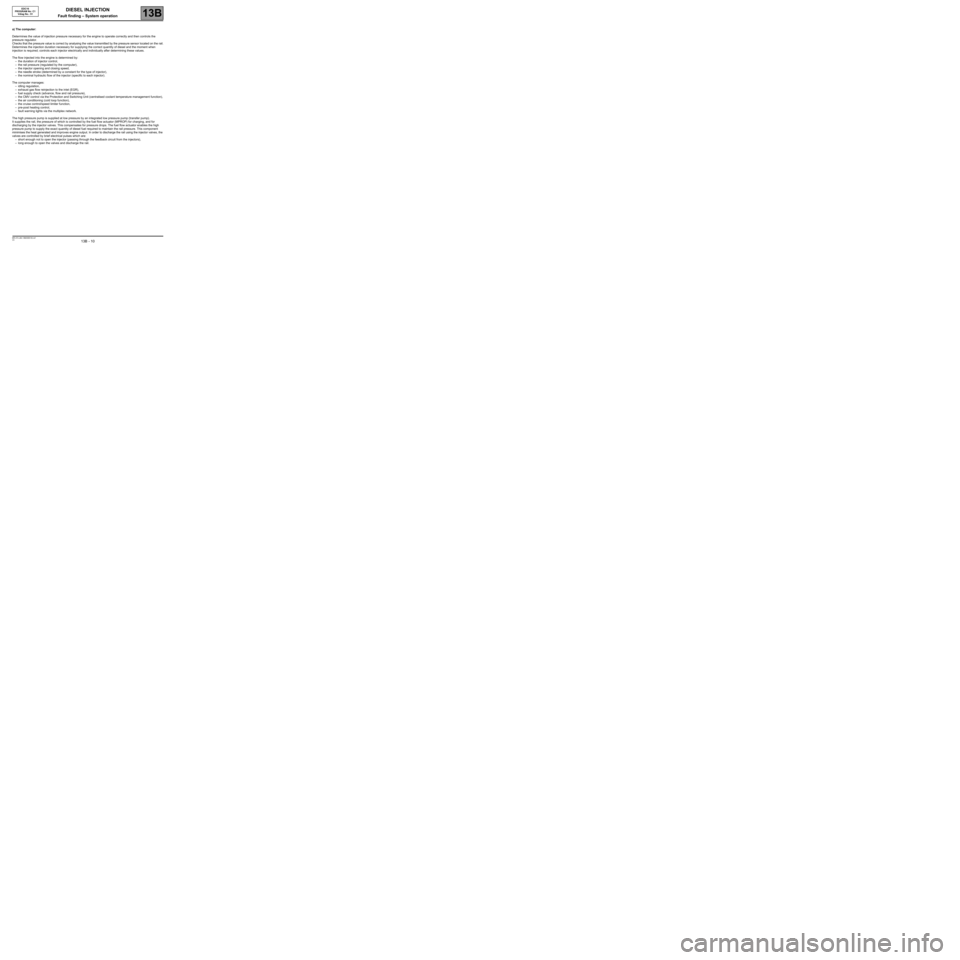
DIESEL INJECTION
Fault finding – System operation13B
13B - 10V3 MR-372-J84-13B250$135.mif
EDC16
PROGRAM No: C1
Vdiag No.: 51
a) The computer:
Determines the value of injection pressure necessary for the engine to operate correctly and then controls the
pressure regulator.
Checks that the pressure value is correct by analysing the value transmitted by the pressure sensor located on the rail.
Determines the injection duration necessary for supplying the correct quantity of diesel and the moment when
injection is required; controls each injector electrically and individually after determining these values.
The flow injected into the engine is determined by:
–the duration of injector control,
–the rail pressure (regulated by the computer),
–the injector opening and closing speed,
–the needle stroke (determined by a constant for the type of injector),
–the nominal hydraulic flow of the injector (specific to each injector).
The computer manages:
–idling regulation,
–exhaust gas flow reinjection to the inlet (EGR),
–fuel supply check (advance, flow and rail pressure),
–the CMV control via the Protection and Switching Unit (centralised coolant temperature management function),
–the air conditioning (cold loop function),
–the cruise control/speed limiter function,
–pre-post heating control,
–fault warning lights via the multiplex network.
The high pressure pump is supplied at low pressure by an integrated low pressure pump (transfer pump).
It supplies the rail, the pressure of which is controlled by the fuel flow actuator (MPROP) for charging, and for
discharging by the injector valves. This compensates for pressure drops. The fuel flow actuator enables the high
pressure pump to supply the exact quantity of diesel fuel required to maintain the rail pressure. This component
minimises the heat generated and improves engine output. In order to discharge the rail using the injector valves, the
valves are controlled by brief electrical pulses which are:
–short enough not to open the injector (passing through the feedback circuit from the injectors),
–long enough to open the valves and discharge the rail.